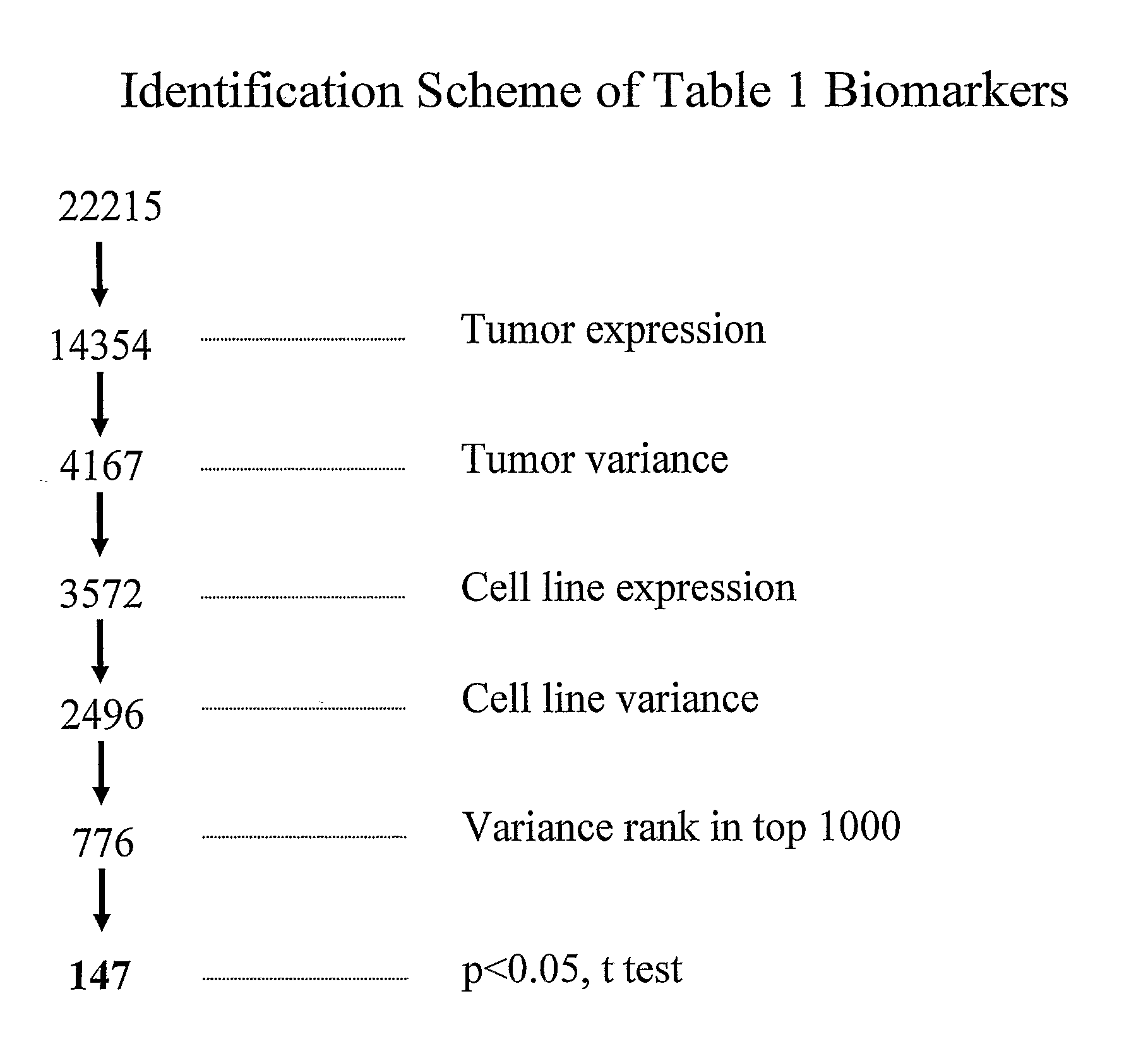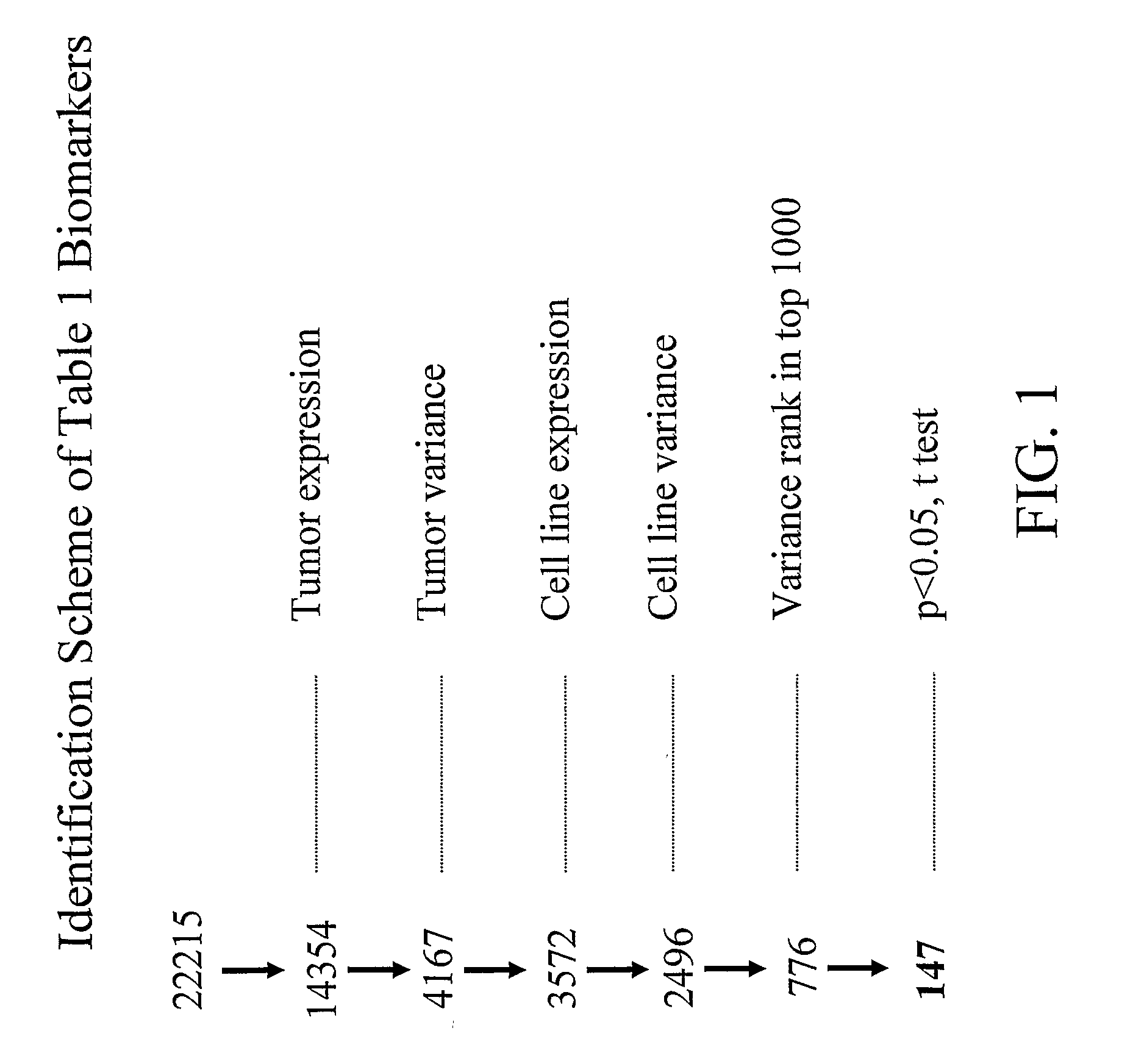Biomarkers and Methods for Determining Sensitivity to Epidermal Growth Factor Receptor Modulators in Non-Small Cell Lung Cancer
a technology of epidermal growth factor receptor and biomarker, applied in the field of pharmaceuticals, can solve problems such as the difficulty of predicting drug sensitivity in patients
- Summary
- Abstract
- Description
- Claims
- Application Information
AI Technical Summary
Benefits of technology
Problems solved by technology
Method used
Image
Examples
example 1
Identification of Biomarkers
[0086] The biomarkers of Table 1 were identified using three particular approaches. The transcriptional profiling data from primary tumors and cell lines was examined to identify genes with expression that is highly variable across the tumors and cell lines. In addition, attempts were made to determine the IC50 on a panel of cell lines in order to identify genes whose expression profiles correlate with sensitive / resistant classification based on IC50 values. Furthermore, cell lines and xenograft models were treated with the chimeric EGFR antibody cetuximab (marketed as Erbitux®) and the small molecule EGFR inhibitor gefitinib to identify genes that are modulated by EGFR inhibitors.
NSCLC Tumors and Patients
[0087] RNAs from twenty-nine NSCLC adenocarcinoma tumors were obtained (Ardais Corporation, Somerville, Mass.). Adenocarcinomas are the most common sub-type of NSCLC. The median age of the patients was 65 years (range: 43-80 years). The tumors belong...
example 2
Experimental Validation of Biomarker Candidates: Cell Line Induction Studies
[0096] Regulation by EGFR inhibitors in drug treated cell lines would lend additional support to the candidate biomarkers as being predictive of response. Induction experiments were carried out in two sensitive cell lines ChagoK1 (sensitive to cetuximab and gefitinib) and L2987 (sensitive to cetuximab, resistant to gefitinib). Induction experiments were also carried out in four cell lines that were resistant to both EGFR inhibitors: A549 and H226 (EGFR+) and LX-1 and H522 (EGFR negative) cell lines.
[0097] Cells were seeded in 6-well tissue culture dishes in DMEM supplemented with 10% FBS (Invitrogen, Carlsbad, Calif.). Twenty-four hours later the cells were switched to DMEM containing 0.5% FBS. The next day cells were treated with either 4 μg / ml cetuximab or 1 μM gefitinib. Twenty-four hours later cells were stimulated with 100 ng / ml human recombinant epidermal growth factor EGF (Biosource International, C...
example 3
Experimental Validation of Biomarker Candidates: Drug Treatment Studies in Lung Xenograft Models
[0100] Regulation by EGFR inhibitors in lung xenograft models would lend additional support to the candidate markers, as being predictive of response. Drug treatment experiments were carried out in the L2987 (sensitive to cetuximab and gefitinib), A549 (borderline sensitive to cetuximab and gefitinib), and LX1 (resistant to cetuximab and gefitinib) lung xenograft models.
In Vivo Antitumor Testing
[0101] Tumors were propagated in nude mice as subcutaneous (sc) transplants using tumor fragments obtained from donor mice. Tumor passage occurred approximately every two to four weeks. Tumors were then allowed to grow to the pre-determined size window (usually between 100-200 mg, tumors outside the range were excluded) and animals were evenly distributed to various treatment and control groups. Animals were treated with cetuximab (1 mg / mouse, q3d×10, 14; ip) or gefitinib (200 mg / kg, q1d14, 14;...
PUM
| Property | Measurement | Unit |
|---|---|---|
| Volume | aaaaa | aaaaa |
| Volume | aaaaa | aaaaa |
| Volume | aaaaa | aaaaa |
Abstract
Description
Claims
Application Information
 Login to View More
Login to View More - R&D Engineer
- R&D Manager
- IP Professional
- Industry Leading Data Capabilities
- Powerful AI technology
- Patent DNA Extraction
Browse by: Latest US Patents, China's latest patents, Technical Efficacy Thesaurus, Application Domain, Technology Topic, Popular Technical Reports.
© 2024 PatSnap. All rights reserved.Legal|Privacy policy|Modern Slavery Act Transparency Statement|Sitemap|About US| Contact US: help@patsnap.com










